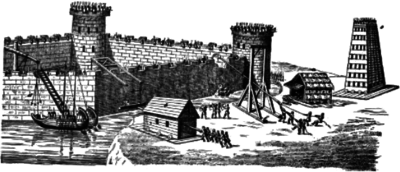Testudo
From DT Online
The Testudo was an effective formation used by the Romans to protect their attacking groups of Legionaries. Testudo is the Latin word for Tortoise. Groups of advancing Infantry formed a Testudo by holding their shields overhead, supported by their helmets, and interlocking them to protect against attack from above. If needed, a similar arrangement was organised along the front and sides.
The Testudo formation was effective at facing off archers for example, or to protect troops during Sieges as they scaled walls, but was slow moving and restricting so the Legionaries would be ordered into another formation for close combat.
Overall, the term Testudo was given generally to protective shelters under which Legionnaries could approach the walls of a besieged fortification to deploy a Battering Ram, for example, or a Musculus (small mouse) to mine under the foundations. (Note: the Roman writer Vegetius in the 4th Century suggested also that the battering ram looked much like a tortoise’s head coming out of its shell).
The Romans often attacked fortifications, not only by scaling their walls, but they also built ramps up to them. Light weight portable shelters known as Vineae (derived from 'Vines' and meaning a moveable bower or Pergola used as a shelter) were woven from Wicker, for example, and joined end to end to form a protective corridor for those building the ramps.
They also built large portable shields or Mantelets to protect those at the front. Larger versions were built which were known as Plutei and these too were used to get near to enemy walls. Often they were on three wheels to make them more maneuverable.
Activity: Find out about Roman Siege Equipment (e.g. Vinea, Pluteus, Mantelet, Testudo, Musculus, Helepolis, Turris, Corvus, Ballista, Onager, Mangonel, Trebuchet, Aries (Battering Ram) and construct a working model or models using Stripwood Technology.


